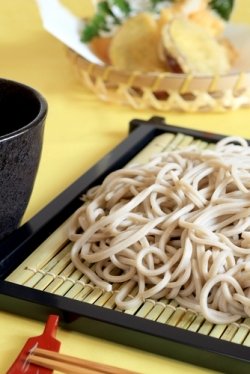Each of the Japanese businessmen at the table have a bamboo “plate” of refreshing, chilled soba noodles, and somehow they are able to do the required slurping to indicate the excellent flavor. Slurping noisily is only one tradition of the myriad surrounding the quintessential Japanese noodle, soba. And though soba is most popular in Tokyo, it is still considered a staple food all over Japan.
 Soba noodles, which are made from buckwheat, have an interesting history all their own, quite separate from Ramen or Udon. Some experts believe that buckwheat came into the southern islands of Japan from Korea in the first part of the seventh century, while others insist that remains of buckwheat pollen have been found in the Northern island of Japan, called Hokkaido, that date back to at least 300 B.C.1 While the origins are unclear, it is easy to see why it grew in popularity as a food throughout the centuries. In Japan in particular, rice is a precious commodity, but it needs a very particular environment in which to grow. Buckwheat, on the other hand, can grow on a mountain, in the cold, in terrible soil and in addition, goes from seed to stem in only 75 days, so it has a short and manageable harvest. In times of famine or drought, people can still grow buckwheat.
Soba noodles, which are made from buckwheat, have an interesting history all their own, quite separate from Ramen or Udon. Some experts believe that buckwheat came into the southern islands of Japan from Korea in the first part of the seventh century, while others insist that remains of buckwheat pollen have been found in the Northern island of Japan, called Hokkaido, that date back to at least 300 B.C.1 While the origins are unclear, it is easy to see why it grew in popularity as a food throughout the centuries. In Japan in particular, rice is a precious commodity, but it needs a very particular environment in which to grow. Buckwheat, on the other hand, can grow on a mountain, in the cold, in terrible soil and in addition, goes from seed to stem in only 75 days, so it has a short and manageable harvest. In times of famine or drought, people can still grow buckwheat.
In the beginning, the Japanese made more dumplings than noodles from the sumptuous meat of the buckwheat. It wasn’t until the early 1600’s that the noodles appeared, possibly out of China. At that time in Japan, the era of the Tokugawa Shogunate had just begun under the spirited leadership of Ieyasu Tokugawa, and even though the emperor at the time had his official residence in Kyoto, he made Edo the capital of the now-peaceful and unified country of Japan. Foreigners in Japan quickly learn that everything in the country has a history and a ritual that dates back to a specific period of the rich and varied tradition of the land. Soba is no different. The change of capital city is particularly significant because Edo was a new city and had to be built up. The laborers who needed jobs flooded into the city in droves, and required sustenance so the noodles were a quick, inexpensive and healthy way to feed the masses. Soba, it was quickly discovered, tasted better than any other type of noodle when served cold, so it overtook udon and ramen in popularity for its speedy preparation and refreshing taste in the summer.
By the late 1700’s Edo was a thriving city and prone to opulence as a capital. The soba shops catered to the upwardly mobile population of the city by emerging as decorative and fashionable places to eat. The formerly sparse stalls redecorated with tatami mats on which to sit and sumptuous lacquered utensils with which to eat. Of course the smaller soba stands still existed to cater to the masses, but the upper class of Tokyo wanted a more refined environment in which to sip sake and enjoy appetizers in addition to the splendid noodles.
It was in 1789 that soba makers from Tokyo discovered that they could further refine the buckwheat and make the noodles out of only the inner section of the grain. Thus, sarashina, or white soba was invented, ostensibly by a chef by the name of Horii, who opened a restaurant called Souhonke Sarashina Horii, which is still in business today, five generations later. In fact, the word Souhonke means “head family, the originator.” Horii was originally a textile merchant but was skilled at making soba, so he was allowed to bring his sarashina soba to the Shogun at the time. The taste was so popular in Kyoto with the Shogun, that the news of the flavor spread to the new capital and it grew in popularity. The white color and delicate flavor of the special soba allowed it to be further flavored with green tea or other seasonal specialties. Some restaurants flavor their soba with chrysanthemums at the time of the chrysanthemum blooming in the autumn and with cherry blossoms in the early spring.
1-Udesky, James. The Book of Soba. New York: Kodansha, 1988.